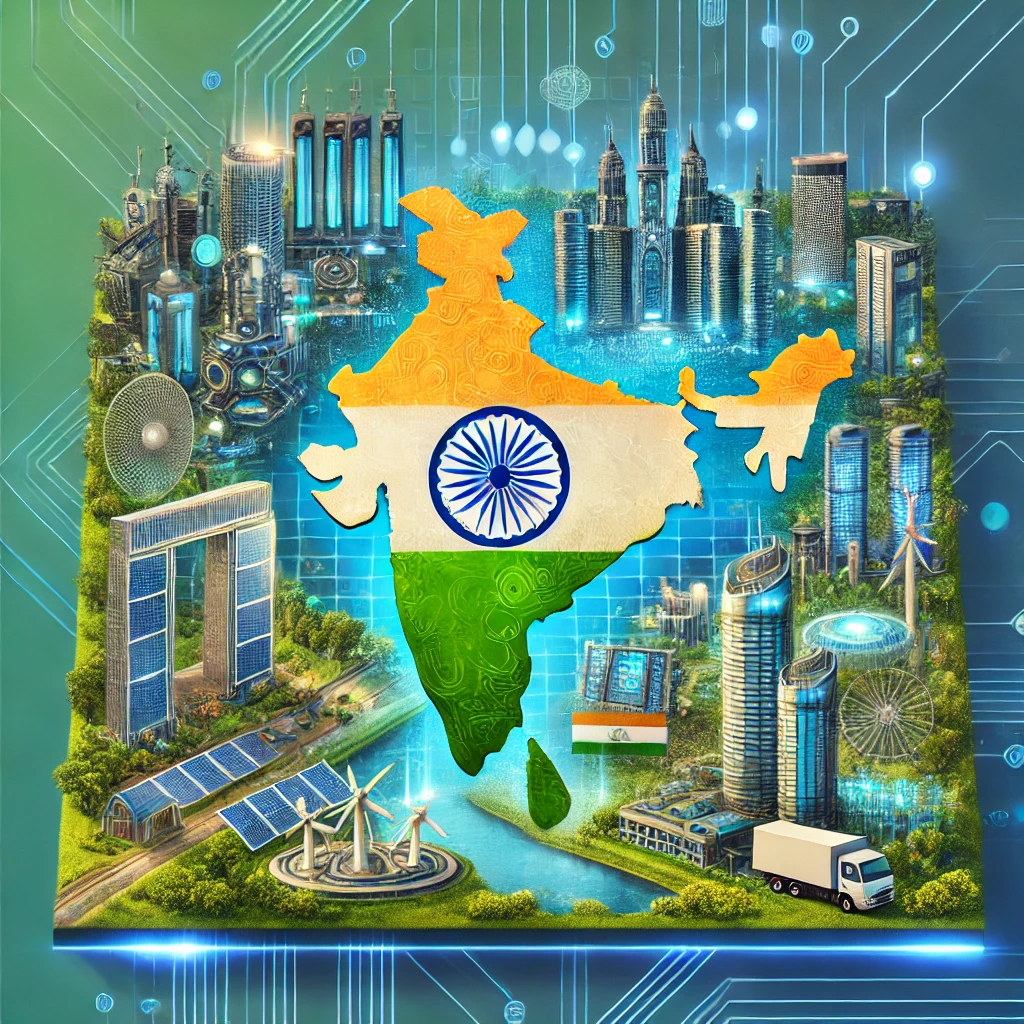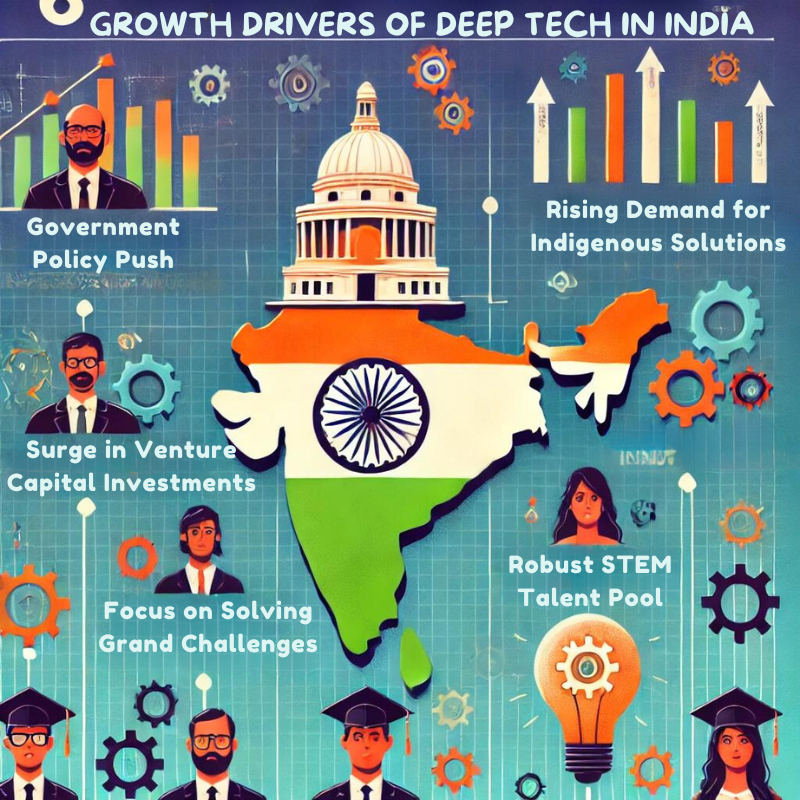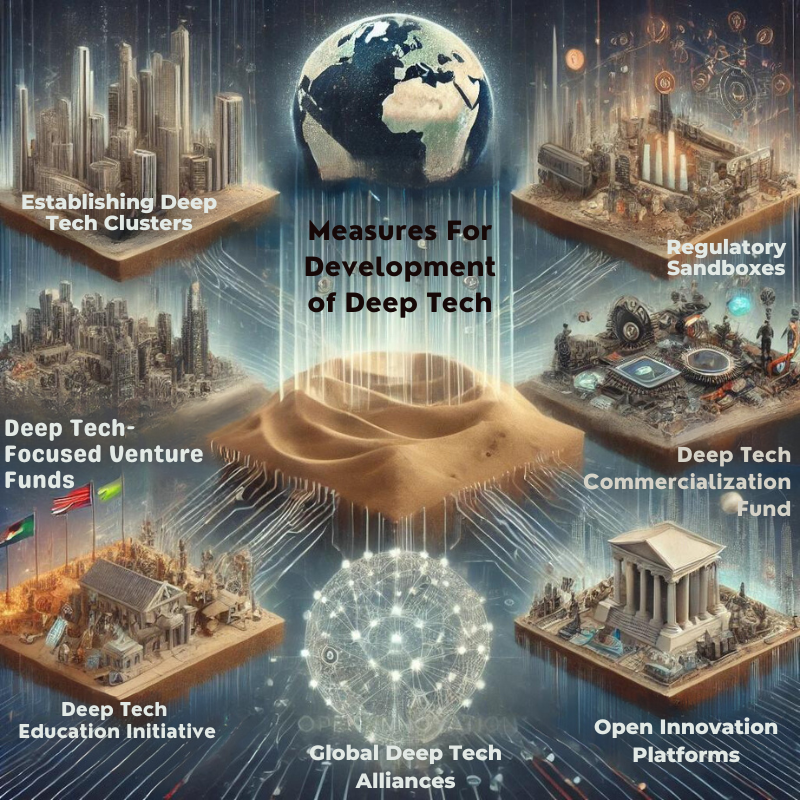Historically, India’s technology story has been about software and consumer Internet. But a rising need for solutions to global challenges in climate change, healthcare, and more recently driven a shift to deep tech. Deep tech startups are those working at the intersection of technology and science, creating innovative solutions enabled by scientific discovery and engineering.
This is part of a new wave of innovation coming out of India complex problems require advanced technologies such as AI, robotics, and biotechnology. Startups like Skyroot Aerospace, a space launch company, and ideaForge, a drone manufacturer, are pioneering solutions that are dominated by established players in the world. The government is encouraging this with various initiatives, including the National Deep Tech Startup Policy and increasing funding to research institutions. This kind of enabling ecosystem, fueled by India’s strong STEM education and vibrant startup culture, positions the country for leadership in the global deep-tech race. That journey, of course, brings its own sets of challenges—as in, navigating a web of regulations to attract the best talent—but India’s deep-tech push may well propel the country to the leading edge of innovation.
| GS Paper | General Studies III |
| Topics for UPSC Prelims | Skyroot Aerospace, Artificial Intelligence, National Mission on Quantum Technologies and Applications, National Deep Tech Start-up Policy 2023, Anusandhan National Research Foundation, Vikram-S rocket, National Supercomputing Mission. |
| Topics for UPSC Mains | Growth Drivers of Deep Tech in India, Major Roadblocks in Development of the Deep Tech Sector in India. |
Origin of the Article
This editorial is based on “India’s march towards deep tech” which was published in The Hindu on 11/09/2024. The article highlights India’s shift from traditional software to deep tech, driven by the need for solutions to global challenges like climate change and healthcare. With strong government support and advanced startups, India is positioning itself for leadership in the global deep-tech landscape.
Relevance for UPSC Students
Understanding the shift towards deep tech is crucial for UPSC aspirants. It relates to topics in GS Paper 2 (India and its Neighbourhood, Bilateral Groupings & Agreements) and GS Paper 3 (Growth & Development). This knowledge can help in writing essays, understanding current affairs, and answering questions in the exam.
Why in News
India’s shift towards deep tech, highlighted in The Hindu’s article, is significant for UPSC aspirants as it reflects a strategic pivot addressing global challenges like climate change and healthcare. This theme connects with previous UPSC questions on innovation, government policy, and technology’s role in crisis management, making it crucial for understanding India’s evolving technological landscape.
What is Deep Tech?
Deep tech is characterized by its foundation in scientific discoveries and engineering breakthroughs. Unlike conventional technology, which focuses on incremental improvements, deep tech aims to turn theoretical concepts into real-world applications. This involves leveraging novel technologies to solve complex problems, often requiring long and uncertain R&D processes.
Deep tech is driven by scientific discoveries and engineering breakthroughs. It turns theoretical concepts into real-world applications, setting it apart from conventional technology. This involves translating innovative ideas into practical solutions, often through extended research and development cycles.
Key Characteristics of Deep Tech
- Scientific Intensity: Rooted in fundamental scientific discoveries or engineering innovations.
- Long R&D Cycles: Typically require extended periods of research and development.
- High Capital Intensity: Often needs significant investment in specialized equipment and talent.
- Potential for Disruptive Impact: Capable of creating new markets or significantly transforming existing ones.
Core Areas of Deep Tech
- Blockchain and Distributed Ledger Technologies
- Artificial Intelligence and Machine Learning
- Robotics and Automation
- Quantum Computing
- Biotechnology and Synthetic Biology
- Advanced Materials Science
- Nanotechnology

Status of India in Deep Tech
India has made significant strides in the global deep tech ecosystem, ranking 6th with 3,600 startups and receiving USD 850 million in funding in 2023. This highlights the country’s growing prominence in deep tech innovation.
India’s Global Ranking
India ranks 6th globally in the deep tech ecosystem, boasting 3,600 startups and receiving USD 850 million in funding in 2023. This reflects India’s rising status and potential in the global deep tech arena.
Focus on Artificial Intelligence
Artificial Intelligence (AI) is a major focus within India’s deep tech landscape, with 74% of startups and 86% of funded startups centered on AI. AI also dominates patent filings, accounting for 41% of all deep tech patents, highlighting its significance.
Growth Drivers of Deep Tech in India
Several factors contribute to the growth of deep tech in India, including government policies, venture capital investments, demand for indigenous solutions, a robust STEM talent pool, and a focus on solving grand challenges.
Government Policy Push
Government initiatives like the National Mission on Quantum Technologies and Applications, the National Deep Tech Start-up Policy 2023, and the Anusandhan National Research Foundation provide crucial support for deep tech growth. These policies create a conducive environment for innovation through financial support and regulatory frameworks.
Surge in Venture Capital Investments
Deep tech now accounts for 20% of annual venture capital investments globally. In 2023, deep tech startups raised nearly USD 40 billion. This trend is reflected in India, with companies like Observe.AI raising significant funds, indicating growing investor confidence.
Rising Demand for Indigenous Solutions
India’s push for self-reliance in strategic sectors like defense and space drives demand for homegrown deep tech solutions. Startups like Skyroot Aerospace and ideaForge Technology exemplify this trend, meeting critical national needs with advanced technologies.
Robust STEM Talent Pool
India’s strong foundation in STEM education provides a rich talent pool for deep tech innovation. With over 1.5 million engineering graduates annually, the challenge lies in retaining and channeling this talent towards deep tech entrepreneurship.
Focus on Solving Grand Challenges
Deep tech startups India focuses on solving significant global issues like healthcare, climate change, and sustainable energy. Companies like Biocon, Syngene, and Cell Propulsion lead in these areas. Thereby, attracting talent and investment while positioning India as a global problem solver.

Major Roadblocks in Development of the Deep Tech Sector in India
Several challenges hinder the development of deep tech in India. These include long R&D cycles, talent shortages, regulatory complexities, market readiness mismatches, infrastructure deficits, intellectual property issues, and funding crunches.
The Long Gestation Conundrum
Deep tech innovations often require extended R&D periods, which clash with the typical 3-5 year investment horizons of most venture capital firms. This funding gap can stifle innovation, particularly in capital-intensive sectors.
The Talent Tug-of-War
Despite a large number of STEM graduates, there is a shortage of specialized talent in deep tech fields. This talent crunch is exacerbated by brain drain, slowing down R&D efforts and increasing innovation costs.
Regulatory Labyrinth
Evolving regulations in emerging fields like drones, gene editing, and AI create uncertainty for startups. This regulatory ambiguity can deter investment and slow down the adoption of innovative technologies.
Market Readiness Mismatch
Many deep tech innovations outpace market readiness, creating adoption challenges. For instance, quantum computing startups face a nascent market, leading to a “chicken and egg” problem affecting investment and market development.
Infrastructure Deficits
Deep tech research often requires specialized infrastructure. India’s lack of advanced computing infrastructure poses a significant roadblock, increasing costs and slowing down innovation.
Intellectual Property Challenges
Securing and defending IP remains complex in India. The high costs of global patent filing and a slower patent grant process can disadvantage Indian deep tech startups in the global innovation race.
Funding Crunch
A 77% drop in funding for Indian deep tech startups in 2023 highlights a significant challenge. The diminished investor pool and preference for lower-risk ventures exacerbate the funding crunch.
Measures to Accelerate the Development of Deep Tech
Several measures can boost deep tech growth in India, including establishing deep tech clusters, creating deep tech-focused venture funds, implementing regulatory sandboxes, launching deep tech education initiatives, developing open innovation platforms, establishing a deep tech commercialization fund, and forging global alliances.

Establishing Deep Tech Clusters
Creating specialized deep tech clusters in major cities like Bengaluru and Hyderabad can foster collaboration and reduce infrastructure costs. These clusters would bring together startups, research institutions, and industry partners, supported by tax incentives and subsidized infrastructure.
Deep Tech-Focused Venture Funds
Establishing government-backed venture funds with longer investment horizons can address funding gaps. The ₹10,000 crore Fund of Funds for Startups could allocate a portion specifically to deep tech ventures, partnering with private VC firms to de-risk investments.
Regulatory Sandboxes
Implementing regulatory sandboxes for sectors like AI, biotechnology, and quantum computing can provide regulatory clarity and accelerate innovation. These controlled environments allow startups to test new technologies with relaxed regulations.
Deep Tech Education Initiative
Collaborating with top IITs and private institutions to create specialized curricula can increase the pool of deep tech specialists. Industry-sponsored PhD programs can further address the talent shortage in emerging technologies.
Open Innovation Platforms
Developing national platforms for key deep tech sectors can facilitate collaboration between startups, corporates, and academia. These platforms can align innovations with real-world problems and create market pull for advanced technologies.
Deep Tech Commercialization Fund
Establishing a fund to support the transition of research to marketable products can accelerate commercialization. This fund can focus on areas like advanced materials, biotechnology, and energy storage.
Global Deep Tech Alliances
Forging strategic alliances with global innovation hubs can enhance India’s deep tech ecosystem. Bilateral innovation funds, joint research programs, and talent exchange initiatives can foster collaboration and innovation.
PESTEL Analysis
| Political: The Government of India promotes deep tech through national policies such as the National Mission on Quantum Technologies and Applications and a draft National Deep Tech Start-up Policy 2023. To date, much political will is expressed in supporting the deep tech sectors with government-backed venture funds and regulatory sandboxes across strategic goals on self-reliance in defense and space. Economic: Deep tech is important to the Indian economy; it draws huge amounts of venture capital investment -20 % of yearly global VC investments and a sizeable $40 billion in 2023 alone. Still, these economic realities continue to weigh: 77% funding drop this past year for Indian deep tech startups. Social: Deep tech innovation in India is supported by a large pool of over 1.5 million STEM talent graduating every year as engineering graduates. However, skill gaps in new-age technologies and brain drain toward global tech hubs continue to pose social challenges in sustaining this cycle of innovation. Technological: Indian deep tech is focused on the latest and most advanced fields, such as AI, robotics, and biotechnology. The ecosystem, powered by a large volume of startups and patent filings, presents a few challenges: a lack of specialized infrastructure and high complexity regarding the development and defense of intellectual property in emergent tech areas. Environmental: The new crop of startups is using deep tech to tackle environmental crises-everything from climate change to renewable energy-pushing technology shoulder to shoulder with ecological sustainability objectives. This also opens paths to innovation in green technologies and climate resilience. Legal: The deep tech legal landscape is complex, changing, and mostly not well-settled; the regulations are usually behind technology advancements. More particularly, intellectual property rights are especially tricky, involving time-consuming and cumbersome processes that may defeat the very objective of being innovative unless their processes are smoothed out. |
Conclusion
India’s tech landscape is witnessing a paradigm shift from traditional software to deep tech, driven by global challenges like climate change and healthcare. To address evolving challenges and accelerate the growth of the sector, NASSCOM recommends a multipronged strategy strengthening innovation clusters, enhancing access to patient capital and computing infrastructure, expediting the National Deep Tech Startup Policy, improving IP frameworks, and developing a robust talent pipeline. Despite challenges, India’s STEM talent and entrepreneurial spirit, bolstered by these measures, position it well to lead in deep tech innovation.
| UPSC Civil Services Examination, Previous Year Questions (PYQs) Mains Q. What are the impediments in marketing and supply chain management in developing the food processing industry in India? Can e-commerce help in overcoming these bottlenecks? (GS Paper III, 2015) Q. With the success of private ventures like Skyroot Aerospace’s Vikram-S rocket and growing participation in the National Mission on Quantum Technologies, discuss the importance of private-sector collaboration in achieving India’s space and deep-tech ambitions. What are the potential risks and benefits? |

